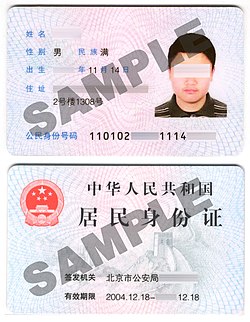This is an old revision of this page, as edited by Benlisquare (talk | contribs) at 13:47, 9 April 2009 (→History). The present address (URL) is a permanent link to this revision, which may differ significantly from the current revision.
Revision as of 13:47, 9 April 2009 by Benlisquare (talk | contribs) (→History)(diff) ← Previous revision | Latest revision (diff) | Newer revision → (diff)This is a draft copy. Please be patient in awaiting the final copy. Thank you.
TITLE: Junmin Shenfenzheng

Junmin Shenfenzheng (Chinese: 居民身份证; Hanyu Pinyin: Jūmín Shēnfènzhèng) is the official form of personal identification in the People's Republic of China.
History
Prior to 1984, citizens within the People's Republic of China were not required to obtain or carry identification in public. On April 6 1984, the State Council of the People's Republic of China passed the "Identity Card Bill", commencing the process of gradual introduction of personal identification, in the footsteps of many developed countries at the time.
Contents
The identity card consists basic information regarding the individual, such as full name, date of birth, ethnicity. Information stored in the identity database documents information such as work history, educational background, religion, ethnicity, police record, medical insurance status, landlord's phone number and personal reproductive history.
Identity card number
Identity law
Usage of identification
Citizens within the People's Republic of China must carry identification at all times, compulsory from the age of 16. The identity card is the only acceptable legal document to obtain resident permit, employment, open bank accounts, obtain passport, driver licence, application for tertiary education and technical colleges, security checkpoints in domestic terminals of Chinese airports.
Anti-counterfeiting measures
